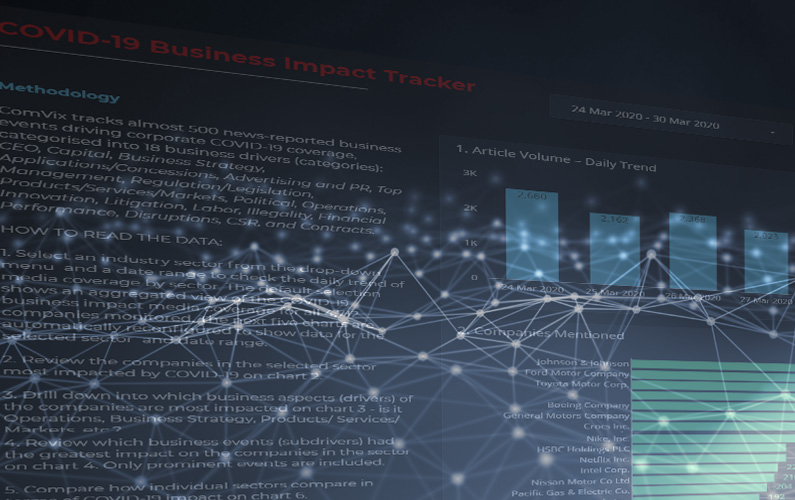Although consumption of media and entertainment content has reached record highs, with viewers stuck at home during lockdowns, future looks fraught for industry players. Their production plans are halted and advertisements have run dry, as many companies cut marketing budgets in anticipation of a recession.
We decided to use the Commetric COVID-19 Business Impact Tracker to analyse the effects of the COVID-19 crisis on the media and entertainment sector. Our free tool uses rule-based natural language processing (NLP) and machine learning to track more than 450 types of news-reported business events that affect companies and industries during the pandemic.
We analysed 149,031 articles from 8,015 online media outlets for the period 1 March – 17 May 2020, covering most publicly-traded companies in the US and the UK, and looked into the business drivers that gained the most traction in the media in the context of the COVID-19 pandemic.
Like many other industries such as Food and Drink, Telco, Technology or Aerospace, the most impactful business driver here was Financial performance, which featured articles primarily on financial forecasts and earnings announcements.
The top-trending story around the industry as a whole was Disney‘s quarterly profit, which suffered a $1.4 billion hit, dropping more than 90%.
The pandemic has affected every part of its business, as it closed its theme parks, cruise lines and retail stores, cancelled high-profile TV and film releases and reduced advertising sales.
The only division during that quarter to improve its position was television, which marked a 7% rise in total income.
The scale of the profit drop made Disney the main company in the media discussion around the media and entertainment sector:
In addition to the Financial performance driver, the conversation around Disney was shaped by the CEO driver: it was widely reported that its outgoing leader, Bob Iger, relinquished his entire salary, while new CEO Bob Chapek will cut his own in half to help his employees.
The company, whose 223,000 workers make it one of the biggest employers in the Los Angeles area, said it would begin to furlough employees “whose jobs aren’t necessary at this time”, resulting in media coverage within the Labour driver.
Similarly, the closures of theme parks, cruise lines and retail stores led to many reports within the Operations driver.
But Disney also performed well in terms of Products/Services since it made “Frozen 2” available on its streaming platform three months ahead of schedule, saying it wanted to surprise families “with some fun and joy during this challenging period.”
However, its donation of 100,000 N95 masks didn’t get as much media traction as the CSR efforts of companies from the Financial Services, Fashion and Health sectors.
In the meantime, Madison Square Garden Company was prominent mainly because of the CEO driver, as its chief James Dolan tested positive for the coronavirus.
Virgin Media, on the other hand, featured in the discussion due to the Products/Services driver: UK citizens’ applauses for the NHS led to an all-time record of upstream traffic on, as people uploaded videos of the moment on social platforms.
There were also some companies whose Innovation activities secured them a relatively large share of voice. For example, Comcast introduced new shoppable ads to help retailers hit by the pandemic at a time when many brands have reduced advertising spending.
A rather unusual story within the Capital driver put Warner Music Group on the map: the recording label, which works with stars like Cardi B, Ed Sheeran and Bruno Mars, listed its shares in a rare IPO after the virus forced many companies to put their plans on hold.
